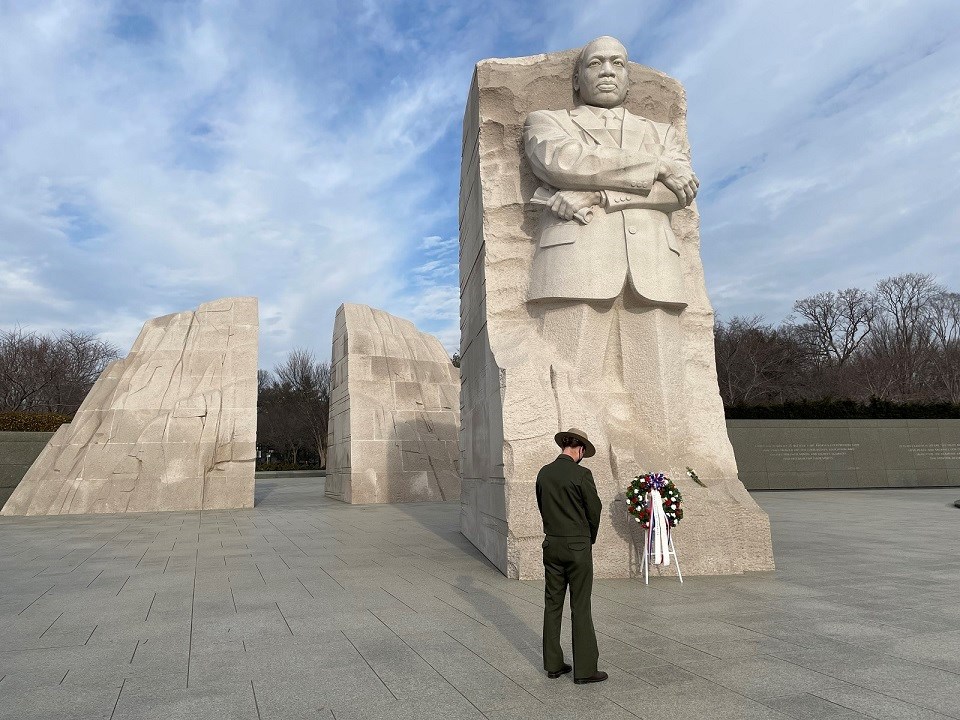Last updated: February 3, 2022
Article
National Park Getaway: Martin Luther King, Jr. Memorial

NPS Photo
More than 50 years after his assassination, Dr. Martin Luther King, Jr. remains one of the most important leaders of the modern civil rights movement. The national memorial to Dr. King and his tireless work for racial equality, the working class and the oppressed around the world sits on the banks of the Tidal Basin in the nation’s capital. Situated between the Lincoln Memorial and the Thomas Jefferson Memorial, the memorial serves as a source of inspiration for activists and those seeking social justice.
As the first memorial on the National Mall to honor an African American, the space is designed to encourage visitors to contemplate Dr. King’s legacy. Congress authorized King’s fraternity, Alpha Phi Alpha, to build the memorial in 1996. More than 900 submissions were received during the open design contest, with ROMA Design Group’s plan for a stone with Dr. King’s image emerging from a mountain was selected from 23 finalists.

NPS Photo
Visitors to the memorial are immediately drawn to the larger-than-life stone carving of Dr. King that was inspired by a line from his historic “I have a dream” speech, delivered at the nearby Lincoln Memorial on August 28, 1963: “With this faith, we will be able to hew out of the mountain of despair a stone of hope.” The memorial’s central feature is a massive granite mountain, from which a 30-foot tall slice has been pulled forward – a literal and figurative Stone of Hope hewn from the Mountain of Despair. Dr. King’s likeness is carved on the Stone of Hope and serves as the focal point of the memorial. The detachment of the stone from the mountain symbolizes ultimate victory borne of initial disappointment.
Inspiring words from Dr. King’s writings, speeches and sermons are engraved on the Stone of Hope, and on the north and south walls of the memorial. These quotations help visitors understand King’s non-violent approach to achieve civil and human rights. Engraved on the statue is “Out of the mountain of despair, a stone of hope," reinforcing the overall theme of the memorial. The South Wall includes excerpts from King’s Nobel Peace Prize acceptance speech and his beliefs about the power of love over hate. The North Wall reveals his arguments for peace and justice for all.

NPS Photo
While visiting the Memorial, stroll over to the bookstore to browse books and souvenirs about the memorial, Dr. King and the civil rights movement. Junior Rangers can pick up a booklet to complete for a National Mall and Memorial Parks Junior Ranger badge. The booklet is filled with activities, games and puzzles that focus on the Martin Luther King, Jr. Memorial as well as other sites around the National Mall. Visitors of all ages are invited to participate in a tour led by a National Park Service park ranger.
The Martin Luther King, Jr. Memorial is also part of the African American Civil Rights Network, which highlights both federal and non-federal sites and programs that commemorate the African American civil rights movement. The network encompasses some 60 properties, facilities, and interpretive programs, all of which help present a more comprehensive narrative of the people, places, and events associated with African American Civil Rights movement in the United States. Some of these sites may be familiar, while others shed light on a lesser-known figure or event consequential to the movement from local, regional, and national perspectives.





